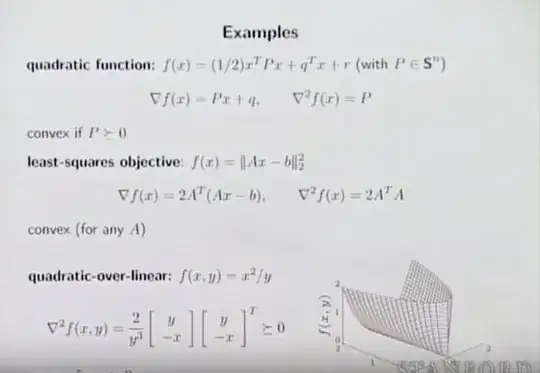I simply would use the Gâteaux-Derivative. That derivative is the natural expansion of the 1D Derivative
$$\frac{d}{dx}f(x) = \lim_{δx→0}f(x+δx)$$to higher dimensions.
Since your function maps $f:ℝ^n→ℝ$ we need an arbitrary direction $δx∈ℝ^n$, and a small increment $ε>0$. Using that "$|_{ε=0}$ formulation the Gâteaux-Derivative for your function reads
\begin{align*}
d(\|Ax-b\|²;[x,δx]) = (\frac{d}{dε}\|A(x+εδx) - b\|²)\big|_{ε=0}
\end{align*}
First it is
\begin{align*}
\frac{d}{dε}\|A(x+εδx) - b\|² =& \frac{d}{dε}[(A(x+εδx) - b, A(x+εδx) - b)] \\
=&\frac{d}{dε}[\{(Ax, Ax)+ (Ax,Aεδx) + (Ax, -b)\} \\
&+ \{(Aεδx, Ax) + (Aεδx, Aεδx) + (Aεδx, -b)\} \\
&+ \{(-b, Ax) + (-b, Aεδx) + (-b, -b)\} ] \\
=¹&\frac{d}{dε}[\{\|Ax\|²+ \|b\|²+ 2(Ax, -b)\} \\
&+ ε\{2(Ax,Aδx) + 2(-b, Aδx)\} \\
&+ ε²\|Aδx\|² ]\\
=& \{2(Ax,Aδx) + 2(-b, Aδx)\} + 2ε\|Aδx\|².
\end{align*}
¹Sorting by powers of ε.
Setting ε=0, yields
\begin{align*}
(\frac{d}{dε}\|A(x+εδx) - b\|²)\big|_{ε=0} &= 2(Ax,Aδx) + 2(-b, Aδx) \\
&= 2(Ax-b, Aδx)= (2A^\top[Ax-b], δx).
\end{align*}
Hence, the derivative is $2A^\top[Ax-b]$.
That is because, $∇f = (∂_{e_1}f, ∂_{e_2}f, …)^T$. So replacing δx with $e_i$ gives: $$∂_{e_i} = {2A^\top[Ax-b]}_i.$$
Higher derivatives can be calculated in the same way:
\begin{align*}
\frac{d}{dε}(2A^\top[A(x+δxε-b])\big|_{ε=0} &= (2A^\top Aδx)\big|_{ε=0} \\
&=2A^\top Aδx
\end{align*}
$⇒∇^2f(x) = 2A^\top A.$
